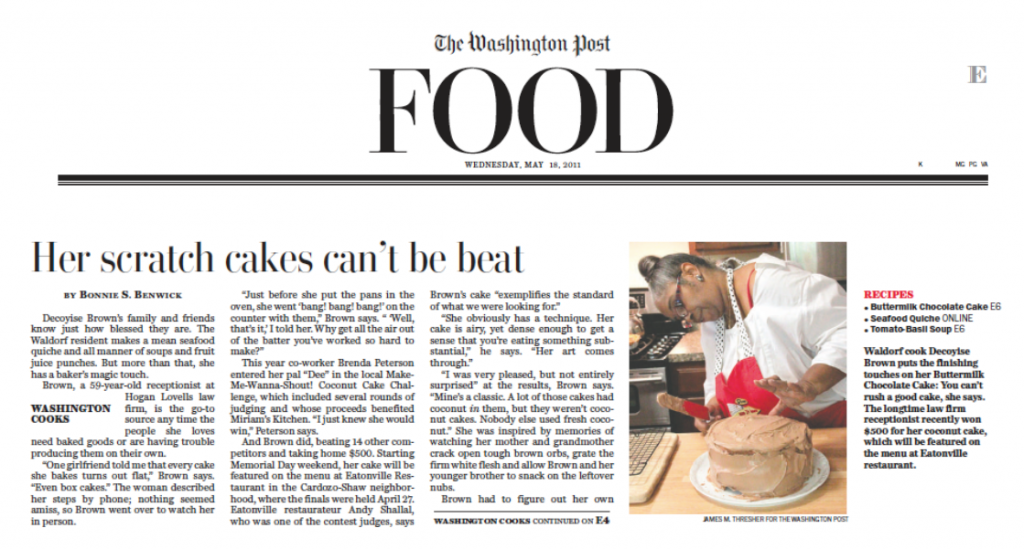Shout out for Church Lady Cake Diaries in new Washington Post Cookbook
 What a surprise it was to see Church Lady Cakes mentioned in the new The Washington Post Cookbook edited by Bonnie Benwick deputy editor for the newspaper’s food section. The shout out is tied to a recipe by Decoyise Brown’s Coconut Cake with [optional] Lemon Filling and Cream Cheese Frosting. If you’ll recall Decoyise was the first winner of the Makes-Me-Wanna SHOUT! Coconut Cake Challenge co-sponsored by this blog. The challenge is now its own entity with media support from here but still in the same family.
What a surprise it was to see Church Lady Cakes mentioned in the new The Washington Post Cookbook edited by Bonnie Benwick deputy editor for the newspaper’s food section. The shout out is tied to a recipe by Decoyise Brown’s Coconut Cake with [optional] Lemon Filling and Cream Cheese Frosting. If you’ll recall Decoyise was the first winner of the Makes-Me-Wanna SHOUT! Coconut Cake Challenge co-sponsored by this blog. The challenge is now its own entity with media support from here but still in the same family.
 Decoyise’s recipe as well as a feature were published in 2011. The cake includes fresh shaved coconut. You can do your own or buy it (without the additional sugar) from the store. I saw some at Whole Foods market. Just as I got the hang of swinging a hammer against the shell. I’ve added The Washington Post Cookbook to our Amazon.com store shelf. If you buy the book, try the chocolate grapes. We got samples at the event made by hand by Bonnie and her team. They were delicious.
Decoyise’s recipe as well as a feature were published in 2011. The cake includes fresh shaved coconut. You can do your own or buy it (without the additional sugar) from the store. I saw some at Whole Foods market. Just as I got the hang of swinging a hammer against the shell. I’ve added The Washington Post Cookbook to our Amazon.com store shelf. If you buy the book, try the chocolate grapes. We got samples at the event made by hand by Bonnie and her team. They were delicious.
Here’s the complete recipe for the coconut cake as it was published in 2011 (online):
Here’s the recipe that won the 2011 Make-Me-Wanna Shout! Coconut Cake Challenge, sponsored by ChurchLadyCakeDiaries.com and Eatonville Restaurant in Washington. It takes effort, but it’s worth it.
The lemon filling is optional, but we highly recommend it. If you make it, you’ll have 1 cup left over. Coconut emulsion, a professional-strength flavoring, is available on Amazon.com and, on occasion, at Ross stores. You’ll have about 1 1/2 cups of frosting left over, which can be frozen for future cupcakes. Take note: The 9-inch cake pans you use here must be at least 2 inches deep. Springform pans may be substituted.
MAKE AHEAD: The lemon filling can be made and refrigerated in an airtight container for up to 2 days. The coconut can be grated and refrigerated a day in advance, and the frosting can be refrigerated up to 2 days in advance.
16 servings
Ingredients:
For the cake
- 1 tablespoon vegetable shortening, for the cake pans
- 3 cups cake flour, plus more for the cake pans
- 16 tablespoons (2 sticks) unsalted butter, at room temperature
- 1 3/4 cups sugar
- 1 cup cream of coconut (not coconut milk or coconut cream)
- 5 extra-large eggs, at room temperature
- 2 teaspoons coconut emulsion, such as LorAnn Coconut Bakery emulsion (see headnote: may substitute vanilla extract)
- 1 1/2 teaspoons baking powder
- 1/2 teaspoon baking soda
- 1/2 teaspoon fine sea salt, such as Morton’s
- 1 1/2 cups regular or low-fat buttermilk
For the lemon filling (optional)
- 1 1/2 teaspoons unflavored powdered gelatin, such as Knox brand
- Finely grated zest and freshly squeezed juice from 4 or 5 lemons (1 tablespoon zest and 1 cup plus 2 teaspoons of juice)
- 1 1/2 cups sugar
- 1/8 teaspoon fine sea salt
- 4 extra-large eggs, plus 6 extra-large egg yolks (reserve whites for another purpose)
- 8 tablespoons (1 stick) chilled unsalted butter, cut into tablespoon-size pieces
For the frosting
- 2 or 3 small coconuts (shake to make sure there is liquid inside)
- Two 8-ounce packages regular or low-fat cream cheese, at room temperature (do not use nonfat)
- 8 tablespoons (1 stick) unsalted butter, at room temperature
- 2 teaspoons vanilla extract
- 1/2 cup cream of coconut (not coconut milk)
- 2 1/2 cups confectioners’ sugar
Directions:
For the cake: Preheat the oven to 325 degrees. Use the vegetable shortening and enough flour to grease, then thoroughly dust, two 9-inch cake pans with sides at least 2 inches high. Shake out any excess flour.
Combine the butter and sugar in the bowl of a stand mixer or hand-held electric mixer; beat on low speed, then on medium-high speed for about 5 minutes or until lightened and fluffy. Stop to scrape down the sides of the bowl. Add the cream of coconut and beat on low speed until well incorporated.
Meanwhile, separate the egg yolks and egg whites, reserving the latter.
Add the first egg yolk to the butter mixture; beat on medium speed to incorporate, then add the remaining yolks one at a time, incorporating after each addition. Then beat for at least 5 minutes, stopping to scrape down the sides of the bowl as needed. Add the coconut emulsion and beat until well combined. Remove the bowl from the mixer.
Meanwhile, sift the 3 cups of flour together with the baking powder, baking soda and sea salt. Beat the egg whites in a clean separate bowl on high speed to form stiff peaks.
Stir one-third of the flour mixture into the butter-egg mixture, then add one-third of the buttermilk; once the mixture is smooth, repeat with another third of the flour mixture and the buttermilk, then with what remains of each, forming a smooth batter.
Fold in the egg whites, gently yet thoroughly.
Divide the batter evenly between the cake pans; use an offset spatula to make the surface even and smooth. Bake on the middle oven rack for about 45 to 47 minutes or until the sides of the cake have pulled away slightly from the pans, the cake tops spring back when gently pressed and a toothpick inserted in the center comes out clean. Transfer the pans to a wire rack to cool for 10 minutes, then place the cake layers directly on the rack to cool completely.
While the cake is cooling, make the filling, if desired: Stir together the gelatin and 2 teaspoons of lemon juice in a small bowl so the gelatin softens.
Heat the remaining cup of lemon juice, sugar and sea salt in a medium nonreactive saucepan over medium-low heat, stirring for about 2 minutes, until the sugar and salt have dissolved. Remove from the heat.
Use a whisk to combine the 4 whole eggs and 6 egg yolks in a medium mixing bowl, beating until the mixture is slightly frothy. Gradually whisk in the lemon-sugar mixture (making sure not to cook the eggs), then whisk in the softened gelatin-juice mixture and lemon zest.
Whisk in 1 tablespoon of the butter at a time; increase the heat to medium and keep whisking so the mixture thickens for about 5 minutes, then reduce the heat to medium-low to keep the mixture from scorching and cook for about 7 minutes; a spoon pulled through the filling should leave a ribbony trail. Remove from the heat; strain through a fine-mesh strainer to remove any solids, pushing the filling through with a flexible spatula. Transfer to a container to cool, or refrigerate until ready to use.
For the frosting: Use a screwdriver and hammer to pierce one of the eyes of 2 coconuts and crack their shells open over a bowl placed in the sink. Drain their milk into a bowl, reserving it for later use. Find the seam that runs between the eyes, which should lead to each coconut’s equator; use a blunt side of a meat cleaver or very heavy knife to tap firmly around the equator as you turn each coconut in your hand. Continue to tap until the coconut splits open, making sure it’s over the bowl in the sink.
Discard the brown skin, then cut the coconuts into large chunks. Use a spoon to scrape out or dislodge the flesh, preferably in chunks. Transfer them to a food processor fitted with a fine shredding attachment, or use a box grater to grate them. The yield should be 3 cups; if not, repeat with the third coconut. Transfer the grated coconut to a resealable plastic food storage bag; use some of the reserved coconut liquid to moisten the flesh. Seal and refrigerate until ready to use, up to 2 days.
Combine the cream cheese and butter in the bowl of a stand mixer or hand-held electric mixer. Beat on medium speed until well combined. Add the vanilla extract and the cream of coconut; beat for about 4 minutes, until light and fluffy.
Reduce the speed to low; add the confectioners’ sugar in 1/2 cup increments and beat each addition until thoroughly incorporated, stopping to scrape down the sides of the bowl as needed. Cover and refrigerate until ready to use, or up to 2 days.
When ready to assemble, invert one of the cooled cake layers on a serving plate. Spread the filling, if using, or some of the frosting almost to the edges of the cake. Scatter about one-fourth of the grated coconut over the filling or frosting. Place the remaining layer, top side up, squarely on top. Spread the frosting generously on the top and sides of the cake.
Working with handfuls of the grated coconut at a time, gently press it against the sides of the cake and scatter it generously over the top. Refrigerate uncovered for 20 minutes before serving. For longer storage, cover the cake in plastic wrap.
Baking and Making Memories
2013 Makes-Me-Wanna SHOUT! Pie Baking Challenge presented with Eatonville Restaurant Entries due February 4, 20132011 Coconut Cake Winner Decoyise Brown
2012 Makes-Me-Wanna SHOUT! Semifinals
March 24, 2012 at Martha's Table
Church Lady Cake Diaries trailer
Tags
A Christmas Memory Alexis Echols Andy Shallal Annalee Ash Austin Brown Bonnie Benwick Brenda Rhodes Miller caramel pie Carla Hall chocolate cake Chow Christine Perez Church Lady Cake Diaries coconut cake coconut cake contest Daryl Wright DC State Fair Decoyise Brown Eatonville Restaurant Edna Lewis fruitcake Jenna Huntsberger Jennifer Donald Joan Nathan Johari Rashad King Arthur Flour Lindsey Wahowiak Makes-Me-Wanna SHOUT! Baking Challenge Makes-Me-Wanna SHOUT! Chocolate Layer Cake Challenge Makes-Me-Wanna SHOUT! Coconut Cake Challenge Makes-Me-Wanna SHOUT! Pie Baking Challenge Martha's Table Michon Boston Miriam's Kitchen Modern Domestic New Orleans PBS pound cake Scott Peacock Scott Schenkelberg Stephanie Woodrow Thanksgiving Valery Flood-Smith vinegar pie Whoopie Pie with


